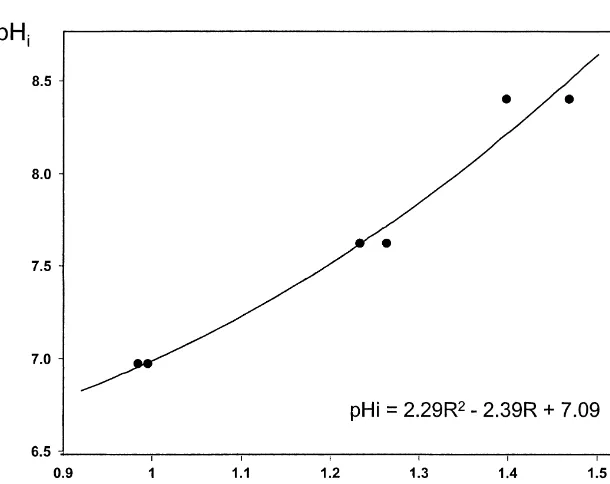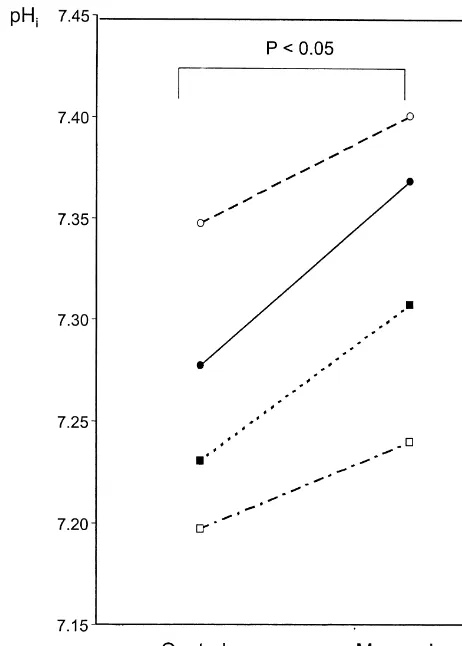Brain Research 882 (2000) 226–229
www.elsevier.com / locate / bres
Short communication
1 1
Effects of the Na / H
exchanger monensin on intracellular pH in
astroglia
*
Yoshiaki Itoh, Mona J. Law, Louis Sokoloff
Laboratory of Cerebral Metabolism, National Institute of Mental Health, Bethesda, MD 20892-4030, USA
Accepted 8 August 2000
Abstract
1 1
Stimulation of astroglial glucose utilization by the Na / H exchanger monensin is only partially blocked by ouabain. The present studies show that monensin also raises intracellular pH in astroglia. Because increased pH stimulates phosphofructokinase activity, the ouabain-insensitive portion of the stimulation of cerebral glucose utilization (CMRglc) appears to be due to stimulation of glycolysis by intracellular alkalinization. 2000 Elsevier Science B.V. All rights reserved.
Theme: Other systems of the CNS
Topic: Brain metabolism and blood flow
Keywords: Phosphofructokinase; Cerebral glucose utilization; Functional brain imaging
Changes in the rate of local cerebral glucose utilization [7,10], but, unlike the stimulation produced by opening 1
(CMRglc) are linearly related to changes in spike fre- voltage-dependent Na channels with veratridine, this 1 1
quency in the terminal zones of an activated neural stimulation is only partially sensitive to Na ,K -ATPase 1 1 pathway [6]. CMRglc has also been reported to be stoichio- inhibition by ouabain [7]. Because monensin is a Na / H metrically coupled to the rate of glutamate–glutamine exchanger, the ouabain-sensitive component of the
stimu-1
cycling [4]. Because both neuronal firing and / or glutamate lation of CMRglc can be explained by Na entry into the release are generally associated with functional activation, cells. The ouabain-insensitive part was postulated to be measurement of local CMRglc is often used to map local due to intracellular alkalinization [7] because phospho-changes in neuronal functional activity [5]. Because the fructokinase activity, the rate-limiting step in glycolysis, is effects of stimulation of a pathway, e.g. the hypo- known to be stimulated by increased pH [9]. The present thalamico–neurohypophyseal pathway, on local CMRglc study was undertaken to determine if monensin does
1 1
indeed raise intracellular pH (pH ) in astroglia under the
are inhibited by ouabain, a specific inhibitor of Na ,K - i
conditions in which it stimulates CMR . The results
ATPase, the increased energy metabolism is attributed to glc
1 1
demonstrate that it does. activation of Na ,K -ATPase activity, in the neurons to
All procedures on animals were in accordance with the restore the ionic gradients partially degraded by the spike
1
National Institutes of Health Guide for the Care and Use of activity [2] and in the astroglia by the Na -dependent
Laboratory Animals and were approved by the National uptake of glutamate released by the nerve terminals [3,4,7].
1 1
Institute of Mental Health Animal Care and Use Commit-There are, however, processes other than Na ,K -ATPase
tee. Pregnant Sprague–Dawley rats were purchased from activity that can require energy. For example, the
conver-Taconic Farms (Germantown, NY, USA). Astroglial cul-sion of the glutamate taken up by the astroglia to
tures were prepared from the cerebral cortex of the glutamine by glutamine synthetase consumes ATP. Also,
1
newborn pups. After removal of the meninges and blood the Na ionophore monensin stimulates astroglial CMRglc
vessels from brains, the fronto-parietal cortices were dissected out and mechanically disrupted by passage of the *Corresponding author. Tel.: 11-301-496-1371; fax: 1
1-301-480-tissue through a 22-gauge hypodermic needle. The disso-1668.
5
E-mail address: [email protected] (L. Sokoloff). ciated cells (2.5310 cells / ml) were cultured at 378C in
Y. Itoh et al. / Brain Research 882 (2000) 226 –229 227
2
humidified air / 7% CO in uncoated 75 cm culture flasks2 was mounted in an inverted fluorescent microscope (Leitz, (Costar Corp., Cambridge, MA, USA) containing high- Wetzlar, Germany) fitted with a Nikon objective lens glucose Dulbecco’s Modified Eagle Medium (DMEM) (Fluor 40 Ph3DL). Excitation light at 495 and 440 nm was (Life Technologies, Grand Island, NY, USA), 10% (v / v) alternately projected from a mercury arc lamp ([688.50, fetal bovine serum (HyClone Laboratories, Inc., Logan, Oriel Instruments, Stanford, CT, USA) by means of a UT, USA), penicillin (100 units / ml), and streptomycin Lambda 10 optical filter changer (Sutter Instrument Co., (100 mg / ml) (Life Technologies). The culture medium Novato, CA, USA), and fluorescent light at 535 nm was was changed every 2 days until the cultures reached captured by a signal intensifier (VS2525, Video Scope confluence, generally about 1 week. The flask was then International, Ltd, Sterling, VA, USA) and CCD camera shaken overnight at room temperature to eliminate loosely (CCDC72, Dage-MTI, Inc., Michigan City, IN, USA). adherent process-bearing cells. The adherent cells were Images were recorded and stored by means of
image-21 21
washed with Ca - and Mg -free Dulbecco’s phosphate- analyzing software (Synapse-IP, Synergy Research Inc., buffered saline (DPBS) (Life Technologies), treated for Monrovia, MD, USA) and a Power Macintosh computer. 1–2 min at 378C with 0.5% (w / v) trypsin (ICN Bio- The region of interest (3003500 mm) for measuring chemicals, Aurora, OH, USA) in DPBS, suspended in four average fluorescent intensities was fixed, and the ratio of volumes of fresh culture medium, and placed in 35 mm fluorescence intensity obtained with excitation light at 495 glass bottom microwell dishes (MatTek Corp., Ashland, nm to that obtained at 440 nm was calculated. Astroglial MA, USA) for pH measurement. The culture medium wasi cultures were first incubated with Hanks’ balanced salt changed every 3 days, and the cultures were allowed to solution (HBSS) containing 2 mM glucose for 15 min of reach confluence and used after 18–22 days in secondary pHi measurement. The medium was then replaced by culture. Some of the secondary culture cells were also HBSS containing 2 mM glucose and 10 mM monensin, plated in 6-well culture plates and examined immuno- and the pH was measured for the next 15 min. The pH ofi
histochemically with antibodies against glial fibrillary both media was adjusted to pH 7.20 before use.
acidic protein (GFAP) (DAKO, Carpinteria, CA, USA) The relationship between pH and the fluorescent in-i
1
and a-vimentin (Roche Molecular Biochemicals, In- tensity ratio was calibrated by the high-K nigericin dianapolis, IN, USA). method [8], as adapted for use in cultured rat astroglia [1]. The cells in the glass bottom culture dish were incubated Calibration curves were determined by incubation of the with the fluorescent dye 29,79-bis-(2-carboxyethyl)-5-(and- cultures for 10 min in the same media as those normally 6)-carboxyfluorescein (BCECF)-acetoxymethylester (10 used in the pH assays, except for the addition of 106 mM
1
nM) (Molecular Probes, Eugene, OR, USA) at 378C for 15 K and 10mM nigericin at several standard pH values, i.e. min. After washout of extracellular dye, the culture dish 7.0, 7.6, and 8.4. Two complete sets of calibrations were
228 Y. Itoh et al. / Brain Research 882 (2000) 226 –229
carried out and averaged. A standard calibration curve was obtained from a computed least squares best-fit of a quadratic equation to the pH values and the corresponding measured intensity ratios (Fig. 1). In the pH assays pHi
was calculated by this equation from the ratio of the signal intensities at 495 and 440 nm (Fig. 1).
The time course of a representative assay is shown in Fig. 2. With the cells in the culture medium pH remainedi
relatively stable for at least 15 min. When the control incubation medium was replaced with similar culture medium containing 10 mM monensin, pH rose steeplyi from 7.23 to 7.32 within 2 min. Replacement with culture medium alone had negligible effects on pH . For each welli
the individual pH values obtained during the 10–15 mini
period following addition of medium were averaged to obtain a mean pH for that well under the control andi
monensin-treated conditions. A total of four wells were assayed, and the pH values in each of them before andi
after monensin addition are graphically presented in Fig. 3. In the control medium the astroglial pH was 7.2560.03i (mean6S.E.M., n54), and after addition of 10 mM monensin, the mean pH rose statistically significantly toi
7.3360.03 (P,0.05, paired t-test).
Phosphofructokinase activity is extremely sensitive to small changes in pH, an increase in pH leading to greater affinity of the enzyme for its substrate fructose-6-phos-phate (F-6-P) [9]. The magnitude of the effect depends on many other factors, such as the concentrations of F-6-P,
Fig. 3. Effects of monensin on pH in astrocytes in four wells. Each linei AMP, etc. [9]. Without knowledge of these potentially represents pH from one well averaged over the 10–15 min period
i
influential intracellular factors it is difficult to relate following medium change. The mean pH in all four wells increased fromi 7.2660.03 (mean6S.E.M.) to 7.3360.03 (P,0.05, paired t-test).
Y. Itoh et al. / Brain Research 882 (2000) 226 –229 229
[3] L. Pellerin, P.J. Magistretti, Glutamate uptake into astrocytes accurately the changes we observed in pH to the ouabain-i
stimulates aerobic glycolysis: A mechanism coupling neuronal insensitive increases in CMRglc caused by monensin [7]. activity to glucose utilization, Proc. Natl. Acad. Sci. USA 91 (1994) Under most of the conditions examined [9], however, a 10625–10629.
rise in pH of as much as 0.08 units is sufficient to enhancei [4] N.R. Sibson, A. Dhankhar, G.F. Mason, D.L. Rothman, K.L. Behar, phosphofructokinase activity several fold, more than R.G. Shulman, Stoichiometric coupling of brain glucose metabolism and glutamatergic neuronal activity, Proc. Natl. Acad. Sci. USA 95 enough to explain the less than 100% monensin-induced
(1998) 316–321. ouabain-insensitive increase in astroglial glycolysis. These
[5] L. Sokoloff, Localization of functional activity in the central findings also reinforce the caveat that not all increases in nervous system by measurement of glucose utilization with radioac-local cerebral glucose utilization or associated changes in tive deoxyglucose, J. Cereb. Blood Flow Metab. 1 (1981) 7–36. blood flow should be interpreted as evidence of increased [6] L. Sokoloff, Energetics of functional activation in neural tissues,
Neurochem. Res. 24 (1999) 321–329. functional neuronal activity. Other intracellular processes
[7] S. Takahashi, B.F. Driscoll, M.J. Law, L. Sokoloff, Role of sodium that influence glucose utilization may also be operating.
and potassium ions in regulation of glucose metabolism in cultured astroglia, Proc. Natl. Acad. Sci. USA 92 (1995) 4616–4620. [8] J.A. Thomas, R.N. Buchsbaum, A. Zimniak, E. Racker, Intracellular
References pH measurements in Ehrlich ascites tumor cells utilizing
spectro-scopic probes generated in situ, Biochemistry 18 (1979) 2210–2218. [9] B. Trivedi, W.H. Danforth, Effect of pH on the kinetics of frog [1] G. Boyarsky, B. Ransom, W.-R. Schlur, M.B.E. Davis, W.F. Boron,
muscle phosphofructokinase, J. Biol. Chem. 241 (1966) 4110–4114. Intracellular pH regulation in single cultured astrocytes from rat
[10] P. Yarowsky, A.F. Boyne, R. Wierwille, N. Brookes, Effect of forebrain, Glia 8 (1993) 241–248.
monensin on deoxyglucose uptake in cultured astrocytes: energy [2] M. Mata, D.J. Fink, H. Gainer, C.B. Smith, L. Davidsen, H. Savaki,
metabolism is coupled to sodium entry, J. Neurosci. 6 (1986) W.J. Schwartz, L. Sokoloff, Activity-dependent energy metabolism
859–866. in rat posterior pituitary primarily reflects sodium pump activity, J.

